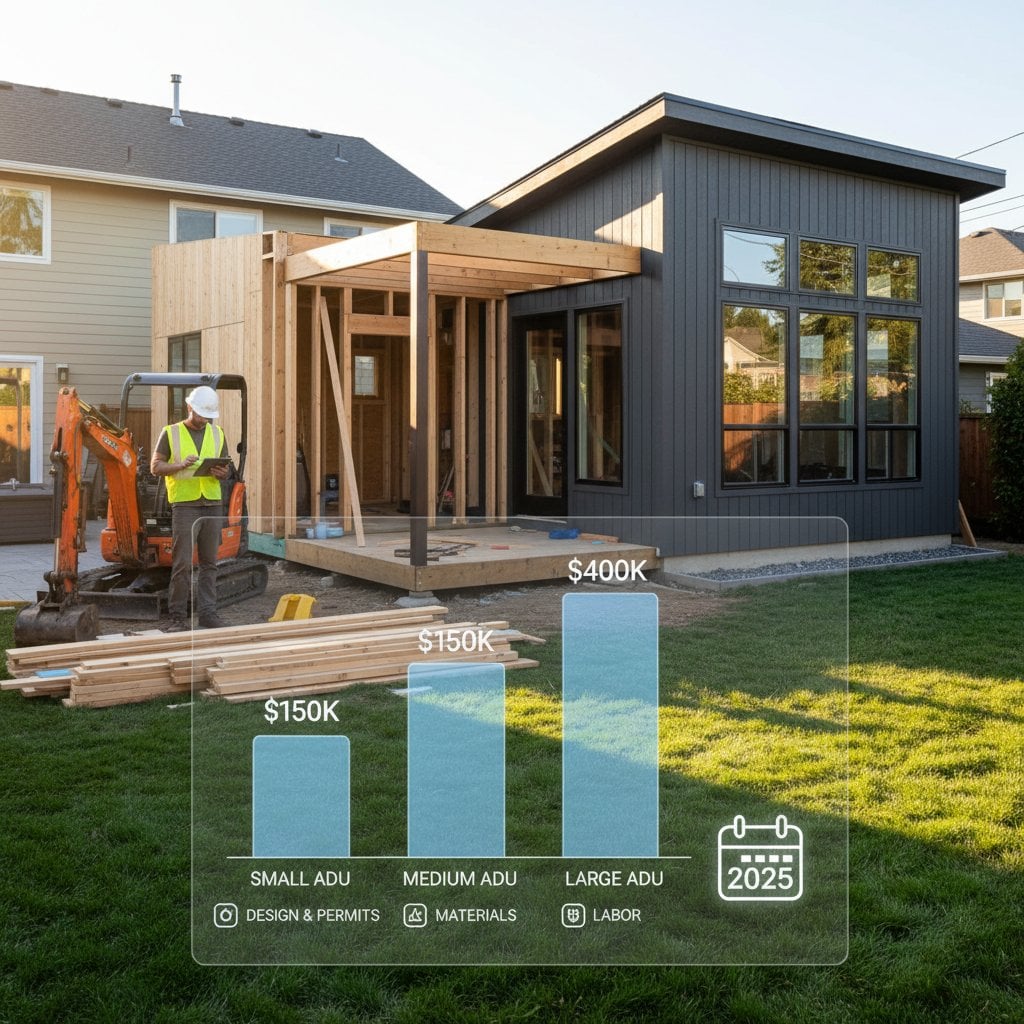2025 ADU Costs Revealed: Plan Your Backyard Build
Adding an accessory dwelling unit, or ADU, expands living space, boosts property value, and generates rental income. Before starting, develop a clear understanding of potential costs for the backyard build. This guide details factors that influence ADU pricing, offers budgeting strategies, and highlights choices that deliver long-term value.
Understanding ADU Cost Basics
ADUs vary in form, from detached cottages to converted garages. Each configuration involves distinct cost drivers. Primary expenses divide into three areas: construction, site preparation, and design or permitting.
- Construction costs encompass framing, roofing, interior finishes, and installations for plumbing and electrical systems.
- Site costs include grading, utility connections, and foundation preparation.
- Design and permit costs cover architectural plans, engineering assessments, and municipal approvals.
These components combine to determine the total build expense. Regional variations and project complexity affect precise figures, yet a detailed breakdown enables confident planning.
Key Factors That Influence Price
Multiple elements shape ADU expenses. Awareness of these allows targeted decisions on investments and simplifications.
-
Size and Layout
Larger ADUs demand more materials and labor. A 400-square-foot studio incurs lower costs than a two-bedroom unit with a complete kitchen and laundry facilities. Compact layouts promote efficiency, though additional features elevate expenses. -
Construction Type
Options range from detached units and over-garage apartments to basement conversions, each impacting pricing. Detached backyard cottages typically prove most expensive due to requirements for new foundations and independent utilities. Conversions offer affordability when the existing structure remains stable. -
Material Quality
Exterior options like fiber cement siding, stucco, or wood differ significantly in price. Premium selections such as metal roofing or custom windows raise initial costs while potentially lowering future maintenance. -
Site Conditions
Challenges like sloped terrain, mature trees, or unstable soil increase excavation and foundation expenses. Level, accessible sites facilitate lower development costs. -
Utility Connections
Extending water, sewer, gas, and electrical services from the primary residence represents a variable expense. Greater distance from main lines heightens trenching and installation fees. -
Permitting and Design Fees
Local regulations vary in processing ADU approvals. Certain municipalities provide streamlined programs, whereas others mandate comprehensive plan examinations. Design fees from professionals typically span several thousand dollars, scaling with customization levels.
Average Cost Ranges by Type
These categories provide estimation benchmarks for ADU projects:
- Garage Conversion ADUs: Frequently the most economical, as the framework exists. Expenses concentrate on insulation, plumbing additions, and interior enhancements.
- Attached ADUs: Constructed as extensions to the main residence, sharing one wall to reduce foundation and roofing needs.
- Detached Backyard Cottages: Standalone structures with dedicated systems. These yield the highest per-square-foot costs yet provide superior privacy and adaptability.
Each approach presents advantages and limitations. Conversions face constraints from prior layouts. Detached options demand extensive permits but permit complete design autonomy.
Cost-Saving Strategies
Thoughtful selections control budgets while preserving quality.
- Simplify the footprint. Opt for straight walls, minimal corners, and conventional roof designs to minimize labor and material waste.
- Select durable yet economical finishes. Materials like vinyl plank flooring or quartz-resembling countertops achieve aesthetic balance with affordability.
- Incorporate prefabricated or modular elements. Builders may supply pre-assembled components that accelerate timelines.
- Position for utility efficiency. Place the ADU nearer to the main house to decrease trenching and connection expenditures.
- Engage ADU specialists. Professionals experienced in compact dwellings optimize approvals and construction processes.
Factors Affecting Long-Term Costs
Initial construction represents only part of the equation. Evaluate ongoing maintenance, energy consumption, and value appreciation.
- Energy efficiency: Features like insulated windows and robust siding diminish heating and cooling demands.
- Exterior durability: Choices such as fiber cement, metal, or treated wood withstand environmental stresses better than basic alternatives.
- Roofing materials: Selections with extended lifespans involve higher upfront investments but defer replacement needs.
- Design flexibility: Versatile layouts accommodate guests, tenants, or relatives across years, enhancing utility.
Steps to Build Your Budget
Identify core objectives first. Determine if the ADU serves rental purposes, family accommodations, or resale enhancement. These priorities guide allocation.
- Develop a comprehensive estimate. Account for site preparation, materials, labor, permits, and a contingency reserve.
- Incorporate a buffer. Surprises in utilities or soil often emerge during construction.
- Evaluate bids thoroughly. Prioritize expertise, references, and scope over the lowest quote.
- Explore local incentives. Regions may provide fee waivers or funding to promote ADU development.
Engaging Professionals for Success
ADU projects require expertise in structural design, electrical and plumbing systems, and regulatory compliance. Advanced construction knowledge proves essential; otherwise, professional involvement justifies the expense.
Select contractors versed in local ADU ordinances and efficient small-space solutions. They manage permits, inspections, and timelines effectively. Delegate non-structural tasks like painting or landscaping to personal efforts for savings, provided safety standards remain intact.
Maximizing Value from Your ADU
A completed ADU introduces versatility to the property. It accommodates relatives, produces rental revenue, or functions as a dedicated office. Effective planning ensures equilibrium among expense, livability, and resilience.
Routine upkeep safeguards the asset. Clear gutters periodically, inspect caulking on windows and doors, and refresh trim paint as required. Such practices sustain both appearance and performance over decades.
Advancing Your Project Forward
Precise budgeting and knowledgeable design selections maintain project momentum. Assess property configuration, zoning requirements, and utility placements initially.
Grasping cost contributors empowers expenditure control alongside creation of a resilient, visually pleasing backyard cottage. Thorough preparation transforms the ADU into a premier home enhancement.










